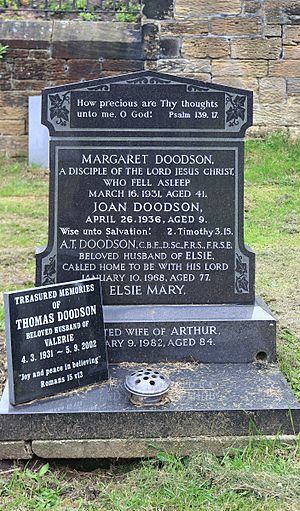Arthur Thomas Doodson facts for kids
Quick facts for kids
Arthur Thomas Doodson
|
|
|---|---|
| Born | 31 March 1890 Boothstown Salford, Greater Manchester
|
| Died | 10 January 1968 (aged 77) Birkenhead, Merseyside
|
| Resting place | Flaybrick Memorial Gardens, Birkenhead |
| Alma mater | University of Liverpool |
| Known for | Doodson numbers |
| Awards | Fellow of the Royal Society (1933) |
Arthur Thomas Doodson (born March 31, 1890 – died January 10, 1968) was a brilliant British scientist. He was an oceanographer, which means he studied the oceans, especially how tides work. His work helped us understand the sea's movements better than ever before.
Contents
Early Life and Learning
Arthur Thomas Doodson was born in 1890 in Boothstown, a town near Salford. His father, Thomas Doodson, managed a cotton mill. Arthur went to secondary school in Rochdale.
In 1908, he started studying at the University of Liverpool. He earned degrees in both chemistry (1911) and mathematics (1912). Arthur was very deaf, which made it hard for him to find a job. He first worked as a meter tester for a company called Ferranti in Manchester.
By 1914, he earned his Master of Science degree from Liverpool University. In 1916, he got a job in statistics in London. Soon after, he began working on calculations for how artillery shells fly. He earned his Doctor of Science degree in 1919.
A Career in Oceanography
In 1919, Doodson moved back to Liverpool. He started working on how to analyze and understand ocean tides.
Understanding Tides
In 1921, Doodson published a very important study about tides. He was the first to break down the forces that create tides into many different parts. He found 388 different patterns of tidal movement. Doodson also created a simple system called "Doodson Numbers." This system helps scientists name and track the many different parts of the tide-generating force.
In 1929, he became the Associate Director of the Liverpool Observatory and Tidal Institute. He spent much of his life studying how tides move in oceans and even in lakes. He was also the first to figure out how to predict tides in shallow areas like estuaries.
Knowing the height of tides and ocean currents is very important for sailors. Doodson's detailed work became the worldwide standard for studying tides. His methods helped create accurate tide tables. These tables allow people to predict tides far into the future.
Tides and World War II
Doodson also worked with and helped design special machines that could predict tides. One famous machine was called the "Doodson-Légé TPM." He also helped write the "Admiralty Manual of Tides" in 1941.
During World War II, the Allied forces planned to invade Nazi-occupied France. They needed to land at low tide so they could see hidden obstacles on the beaches. Doodson was asked to calculate the tidal patterns. His calculations showed that June 5-7 would have the best tides and a full moon. This led to D-Day happening on June 6, 1944.
By 1943, the team at the Liverpool Tidal Institute was very small. It included Doodson and six young women. They also helped with "nighttime fire watch" on the roof. They wore helmets and carried water buckets in case bombs hit the observatory.
Personal Life
Doodson held strong personal beliefs. He was married twice. In 1919, he married Margaret. They had a daughter who sadly passed away in 1936. He also had a son, but his first wife died shortly after his birth in 1931. In 1933, he married Elsie May, who survived him.
Arthur Doodson passed away in Birkenhead on January 10, 1968. He was buried in Flaybrick Memorial Gardens.
You can find more information about him at the National Oceanography Centre. Their Liverpool building used to be the Liverpool Observatory and Tidal Institute, where Doodson later became the director.
Awards and Achievements
In May 1933, Arthur Doodson was chosen to be a Fellow of the Royal Society. This is a very high honor for scientists. His nomination recognized his important work:
He was honored for his work on how tides work and how to understand tidal observations. He greatly improved how we break down the forces that cause tides into their main parts. He also helped analyze tidal observations from expeditions to the Antarctic. During the war, he made important contributions to ballistics (the study of how projectiles fly), making calculations much better. He also did valuable work in statistics and creating math tables.
See Also
- Oceanography
- Tide
- Doodson numbers


